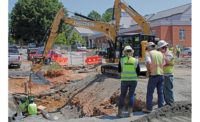West 215th Step Street
New York City
Best Project
Owner NYC Dept. of Design and Construction
Lead Design Firm AECOM
General Contractor ACME Skillman Concrete Co.
Consultant Resident Engineering and Inspection Services (REI) SI Engineering PC
Architect WXY Studio
Originally built in 1915, West 215th Step Street has since become one of the most iconic landmarks in the Inwood section of Manhattan.
The renovation of the 250-ft pedestrian walkway consisted of demolition and reconstruction of existing stairs, along with reconstruction of sidewalks and concrete benches.
The new design maintained the street’s historic character by keeping the original dual staircase design and rehabilitating and reinstalling two historic lampposts. New storm and sanitary sewers, hand railings, precast concrete bicycle channels and street lighting were also installed.
“The West 215th Step Street has connected Inwood residents to the subway and local businesses for a full century, and we are happy to continue that legacy with the reconstruction that was completed in February,” said Feniosky Peña-Mora, commissioner of the NYC Dept. of Design and Construction. “The Step Street serves as an option that expedites travel through the neighborhood and encourages pedestrians to exercise by walking up and down the stairs to reach their destinations. With the addition of bike channels, we also hope to encourage cyclists to incorporate Inwood in their routes with the knowledge that they can easily access the neighborhood without having to carry their bikes.”
During demolition, the team discovered that the vaults underneath the existing stairs were more extensive than originally thought; the walls supporting the old stairs did not have adequate foundation and steel reinforcements. A new support system had to be designed and constructed before demolition could continue.
Large trees and the uneven terrain required use of a crane to lift the trees and place them in the tree pits. One side of the steps was kept open during the entire project at the request of the community, forcing contractors to work sequentially, with little room for multitasking.
The inspection team’s familiarity with the project scope, plan specifications, requirements and pay items, along with good record-keeping practices, was critical for cost control.









Post a comment to this article
Report Abusive Comment